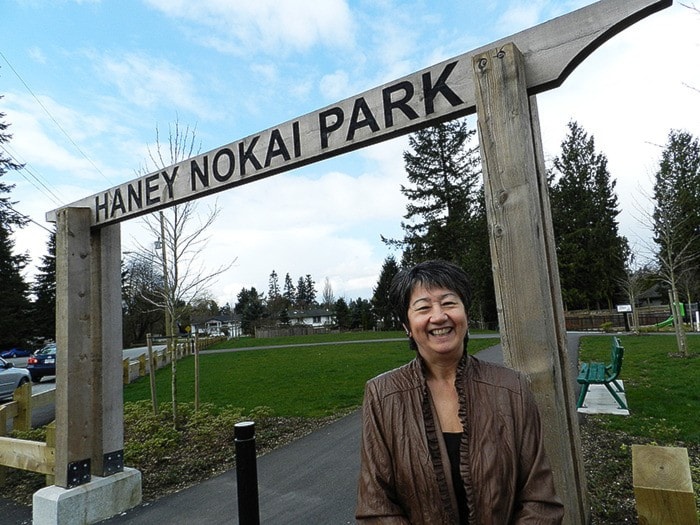From their modern home off Dewdney Trunk Road, Masaru and Machiko Kosaka can almost see the old farms that were sold from under them when they were ordered to leave Maple Ridge in 1942.
It was Labour Day and Masaru and Machiko, still in their late teens, were part of the final round of expulsions from Maple Ridge.
Following the Japanese attack on the U.S. in Pearl Harbour, and misguided security concerns, a federal cabinet order required Canadians of Japanese ancestry to be evacuated beyond 100 miles from the coast.
Masaru and Machiko were among the last to be shipped out. But because their parents had enough money, were sent to a self-supporting camp in Lilloett, then made their way to 70 Mile House, where Masaru lived independently and found regular jobs in logging camps and sawmills.
“As long as you were self supporting, it was OK,” said Masaru, adding a joke, “With no bombs.”
The couple worked in 70 Mile House for the next two decades, got married in Lilloett in 1949 and only returned to Maple Ridge in 1959, after a 17-year absence.
Their brief recollections came after a recent kitchen-table get together in their son’s home, and a few months after the opening of a new park in Maple Ridge on 222nd Street – Haney Nokai Park.

The name refers to the Japanese farming associations that were created before the Second World War, when Japanese-owned farms were thriving throughout Maple Ridge.
According to the book Haney Nokai, written by Yasutaro Yamaga, one of the pioneers profiled on a plaque in the park, there were at least 220 Japanese-owned farms in the area.
While the Kosakas were sent to a “self-supporting area,” most were sent to either road work camps or to internment camps in the B.C. Interior. Families could also stay together if they worked on sugar beet farms on the prairies.
As reported in the Gazette’s Sept. 9, 1942 issue, the final evacuation caught many by surprise, although some remained in Whonnock and Ruskin.
“Several of the families affected by the order had been resident in the district for 30 to 40 years,” and many felt they’d be remaining there longer.
The paper also noted the removals “saved a possible problem in the schooling area,” because the school board had refused to accept children of Japanese origin.
In the days following Pearl Harbour, the tensions must have been high, as evident in a plea by community leader Yasuaro Yamaga, one of the founders of the Haney Nokai.
Yamaga said in the Dec. 12, 1941 of the Gazette that Japanese schools taught Canadian values while also delivering a message to his own community: “My heart is here in Canada. Whoever protects you, you must be loyal to him. I acted in the past 30 years as a Canadian and I am asking my countrymen to do the same.”
Masaru, born in Richmond and now 89, can’t say whether his family ever received compensation for the land that was taken from them. His and his wife’s parents had 100 acres in the pre-war years, producing greenhouse tomatoes and cucumbers.
But he does know he received the $21,000 in redress that the federal government paid all victims of the expulsion in 1988.
Masaru sees the payment as a symbolic gesture and points out those who had their land taken away took the biggest hit.
“For some who had lots of land, I guess it was a big loss.”
But he was pretty young at the time and didn’t have much.
“I think I bought a car.”
Many people who survive tragedy will attest to the wisdom of not letting the experience define them.
The Kosakas live that philosophy.
“There’s no use crying about anything. It doesn’t do anybody any good,” Machiko says.
Machiko, born in Maple Ridge and now 88, doesn’t recall being afraid during the massive relocation, which destroyed finances and disrupted careers. In all, more than 21,000 people in B.C. were uprooted from their homes, the B.C. Security Commission reported in 1942.
“We were younger then,” she said. “What else can you do?”
“Nothing happened,” she says, referring to feared security incidents or acts of sabotage against the Canadian war effort on behalf of the distant Japanese empire.
“Nobody did anything. Waste of money.
“It was amazing that nothing happened. [But] just to be sure, they had to evacuate.”
Masaru remembers being enrolled in cadets in high school in Vancouver, then being kicked out simply because he was Japanese, shortly after the attack on Pearl Harbour.
“We were enemy aliens, although we were born here.”
“We were Japanese, but we were really Canadian. We just looked Japanese.”
One of the tougher parts was the gathering point in Vancouver on the grounds of the Pacific National Exhibition, a place where more than 8,000 people passed through, living in livestock stalls.
“They were herded like cattle,” he adds. “Those buildings are still standing there.”
Even after the war, Japanese-Canadians weren’t allowed to return to the coast. They were given the option of either going to eastern Canada or if their loyalties were suspect, sent back to post-war Japan.
It took until 1949 before Japanese-Canadians gained full citizenship rights and allowed back on the coast.
The couple, now married 64 years, attended the park opening last fall.
The ceermony was important for daughter-in-law Mavis Kosaka.
“It was just interesting for our kids … to see what their grandparents went through. Just the history was really good for them.”
